Along with 7,300 other runners, Skip Schott received the dreaded email from The B.A.A. last week. While he ran a qualifying time for the 2019 Boston Marathon, his entry for the 2019 Boston Marathon was not accepted.
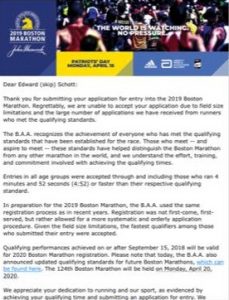
Skip’s official time of 3:25:10.5 was 2-1/2 seconds too slow. He needed a time of 3:25:08 to be accepted into the field. For runners to be accepted into the 2019 Boston Marathon, they had to run a time that was 4 minutes and 52 seconds faster than their qualifying standard. Skip’s time was only 4 minutes 49-1/2 seconds below his standard of 3:30:00.
But there is more to this story.
Bayshore Marathon
Skip earned his qualifying time at the 2018 Bayshore Marathon.
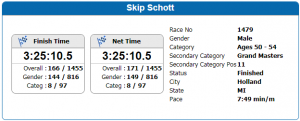
The Bayshore Marathon is a chip-timed event. However, Skip’s net time and finish time are identical. This would indicate that he started with the elite runners (he did not).
At the time of the race, Skip emailed timing officials about his result. The response he received, was as follows:
“Skip, unfortunately we cannot adjust. Official Bayshore times are Gun Time”
A quick look at the results shows that other runners are credited with a chip time different than their gun time:
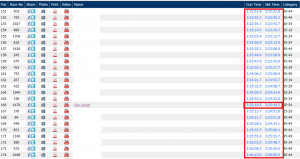
Even the runners that started from the front have a slight variance between gun time and chip time. Typically clock time is only used as the official time for the top competitors. This is so the elite fields know where they stand – whoever crosses the finish first is the winner. But for purposes of age group awards, and Boston qualifying, chip times are the standard.
We could easily assume that Skip started more than 2-1/2 seconds after the gun time. However, we have evidence that proves that he started much further back.
Skip sent me his GPS file and a link to his Strava. Using the Flyby feature of the Strava, I was able to identify another runner that crossed the start at approximately the same time as Skip:

The other runner that I identified as starting at approximately the same time as Skip is in the Bayshore Marathon results with a chip/gun differential of 30.3 seconds.
Additionally, Skip provided the names of two runners that he started the race with. Those runners also had an approximate 30-second differential.
The data is clear that Skip should have been credited with a chip time of approximately 3:24:40, safely below the time of 3:25:08 needed to be accepted into the 2019 Boston Marathon.
What Happened?
It was my immediate belief that Skip’s chip did not register at the start, which resulted in the system defaulting to the gun time. He was also missing a split time from mile 16. It should be noted that he is seen on the race video at the turnaround point, and GPS confirms that he did run the entire course.
I asked Skip for any photos he had, and the cause for these issues was immediately apparent. Skip had his bib attached to his bib belt, but the bib was behind him. This resulted in the missed reads at the start and mile 16. Most timing systems are highly reliable, but when the chip is embedded in the bib, it is important to have the bib on the front of your body to ensure that it registers at all mats. 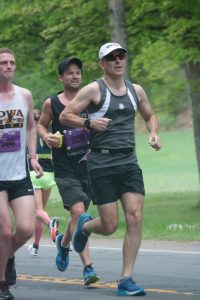 Conclusion
Conclusion
While this situation likely could have been avoided had Skip worn his bib on the front of his body, I don’t believe his failure to do so should disqualify him from running the 2019 Boston Marathon. He immediately notified the timer, who was dismissive at the time.
I point out the bib location in an effort to educate other runners to avoid situations that can arise from missed timing mats. Always keep your bib in front of your body and on your outermost layer.
There is ample evidence that he started 30 seconds after the gun, which would result in an adjusted time that easily would gain him entry into Boston. The race would only need to accept that he started 3 seconds after the gun in order for his qualifying time to be good enough for Boston acceptance.
I believe, based on the evidence, that the Bayshore Marathon should adjust Skip’s official time and that he should be granted entry into the 2019 Boston Marathon.
I have reached out to both the Bayshore Marathon and the B.A.A. The B.A.A. responded that the race would need to acknowledge the discrepancy and work with the timing company to make the change. I will provide updates as appropriate.
To support Marathon Investigation, consider making a small contribution.
Don’t want to use PayPal? Click below to contribute without going through PayPal.

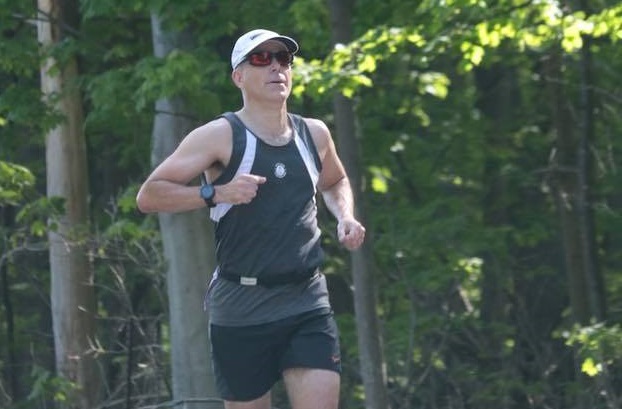

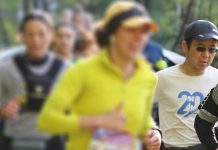





He wants an adjusted time that can’t be accurately determined. Unless there is a video of him crossing the start with a accurate and validated clock in the frame the rd will just be making up a time.
And the bib on the back is a poor excuse. He should know the rules and being a triathlete is not an excuse
Is Bayshore big enough that a 30s chip/gun time differential appropriate? Top 200?, he should basically be starting 2-3 rows back. It’s a couple iffy decision that compounded
He was not making that excuse. That was my (apparently) inaccurate commentary.
I have his Strava showing him crossing the line with another runner – the other runner has a 30 second differential. He says he started with two friends – also with a thirty second differential. They would not be making up a time.
I also included a screenshot of those that dinished about the same time. The differential is appropriate.
It’s his word that he started near those 2. Then we are going to use GPS data (that can be manipulated) collected by a civilian device and processes by a 3rd part app to validate his claim. My garmin tells me I start my runs in the middle of a lake occasionally, my dry shoes say otherwise
An experienced athletes going for a Boston time he knows will be close should not be starting 30 seconds back in a race this size.
It’s nice to see a story going the opposite way but I predict Skip will have to be disappointed on this one. I would think the differential between gun and clock would be easily recognized by Bayshore RDs but what time should they credit him with instead? The bib error is going to cost him.
Maybe you could do a story on (various) timing systems and how they actually work? (Yeah ‘let me Google that for you’ etc. – just another content idea)
The race needs to decide exactly how much to adjust his time, and without definitive data (GPS data is *not* definitive), it’s impossible to do that. The only definitive data that the race has is when the runner finished, no start data. They’ll assume you started in the front, because anything else is “benefit of the doubt”, and that’s not fair to everyone else who crossed the line.
This also isn’t just about adjusting it somewhere between 3 and 30 seconds for Boston’s sake and calling it a day, because it’s not just about Boston — it’s about the marathon’s results as well, and the difference of a few seconds could (without my looking at the results) disrupt age group standings (BQ runners are regularly in the age group award conversation).
I can’t tell you how many times I’ve heard races stress that the bib MUST be worn on the front. There’s a reason for this warning, and sadly, Skip is being made an example.
I’m sort of sympathetic to the guy, but for more than 100 years, racers have been instructed to wear bibs on the front of their clothes. This is so race officials can identify the runners, distinguish registered runners from bandits, sell photographs, and use photographs to verify claims. These functions are not possible when runners put bibs on their backs, or in their pockets, or underneath layers, and as now seems apparent, chip timing isn’t reliable either when bibs are not in front. But Skipper knew better. Don’t want those pins in my nice singlet, says Skip. Don’t want that bib flapping around my belly, says Skip. It would be too much to DQ Skip. But he may pay for his little act of rebellion by being left out of the Big Dance.
Ok, Vinnie.
Hey Vince. I agree that racers should know to wear bibs in front, BUT the type of harm that resulted from wearing the bib in back (chip time issue) was not foreseeable. I never would have guessed that wearing the bib in back would affect one’s chip time, and I can’t imagine most others did before reading this story.
Read the rest of the comments here. It’s pretty clear from the Bayshore directions that the bib needs to be worn on the front.
“I never would have guessed that wearing the bib in back would affect one’s chip time, and I can’t imagine most others did before reading this story.”
Actually many of us do realize it could affect one’s chip time (or having one) – and experienced racers should.
Although Mr. Schott certainly didn’t help himself by not having his bib on the front, chips aren’t 100% even if worn correctly. We’re getting greatly improved read rates the last 3 years, and it continues to get better every year, but not 100% and I don’t ever see us getting to 100%.
I work for a company that produces a 2000+/- runner marathon that also has an 1800+/- team marathon relay. This year, out of 3670 marathoners and relay teams who our timing system picked up at at least one of our 8 chip mat locations, 48 chips did not read at the start mats. (We use B-Tags for marathoners and half marathon relay teams, “tri tags” for our 5-Person relay teams, and D-Tags for our wheelchair racers.) Note that we did verify that all 48 start line no-reads were actually at the start line, didn’t start early or anything like that. We had 30 chips that did not read at the halfway point. Both of those no-read rates are well within what the chip companies publish as an expected no-read rate. The higher start line no-read rate is to be expected due to the much greater density across those mats as opposed to later in the course when things are spread out.
In our case, and if Bayshore is different I must say I’m surprised that they would be, if a runner complains that their chip didn’t read at the start we will do some research to try to pin down their actual lag time across the start line. We have video and still photography of the start and not too far into the course. We’ll ask the runner for details that we can corroborate, such as other runners they were near at the start or the net time on their gps watch. We’re not 100% at figuring it out and we don’t fudge times if we don’t have solid proof, but it’s not been that difficult to sort chip no-reads out. If anything is questionable we’ll at worst underestimate the lag.
Thanks for the insight. Does the location (e.g. front or back of runner) affect whether the chip is read? It would surprise me if wearing his bib on his back the way he did contributed to the no-reads, but I suppose it’s possible.
Of the 48 non-read chips at the start and 30 at halfway, how many chips failed both mats? Just wondering.
Just for a little more info on this:
The race in question was run in the spring of 2018. As of the fall of 2016 (and for years prior before), the FAQ page for this race explicitly stated that bibs must be worn on the front and explained that the reason for this was so that the mats could record accurate start and finish times for purposes of determining chip times:
https://web.archive.org/web/20161104065413/http://www.bayshoremarathon.org/faqs
”
Q: What method of electronic timing is used for the Bayshore?
A: This year’s Bayshore events will be timed with state of the art RFID timing using UHF tags that are attached to your race numbers. You don’t need to know anything about the technology of how this system will capture your time from start line to finish line (If you do you can read about it at rftiming.com) but you will need to be sure you pin your race number on the FRONT of your shirt or singlet so that the system can read your tag, starting your time as you cross the actual starting line and stopping it as you cross the finish line.”
I’m not saying whether I believe anyone should be left out of Boston on account of this. Just want to provide a bit more information on the situation.
He should have been penalized for wearing a bib belt, a hat and sunglasses, and disqualified for wearing the bib on his back.
Why? What’s wrong with wearing a hat and sunglasses? I always wear a full belt (water bottles and phone pocket) and a hat or visor and sunglasses. Why is that bad?
I assume that was a sarcastic reply to my comment faulting him for wearing his bib on the back.
Good lord, why would you wear a full belt with water bottles and bring your phone? It’s a race. The hat’s not a big deal under the right circumstances, but the sunglasses are almost never necessary.
Unless you have light sensitive eyes. My wife does with the contacts she wears and even with a hat it can be tough on her. Not everyone is made the same you know…
1) Sometimes the light bothers my eyes, even with a hat.
2) I’ve had some bad experiences with race-provided water (ie, empty water stations).
3) I carry my phone in case something happens. I get injured. Something stops the race (Boston or San Diego). I can’t find my ride at the meet-up spot.
I run with all of that stuff for all of my training (more water, or course), so to not have it would throw me off. And it’s not like I’m running fast. I’ll never be the subject of any investigation here, that’s for sure!
I always wear sunglasses… a hat sometimes. Even on cloudy/overcast days, I need it for my eyes. I carry my own water, and yes, my phone. Why? I train that way… so I want everything the way I train. To each their own. I don’t make fun of the barefoot guy who runs in khaki shorts if that’s how he’s comfortable running… don’t be snobby.
I use sunglasses because I wear contacts and get a glare. I also generally use my phone so I can be live tracked on Garmin. I’m also not close to being a BQ runner but a hat, glasses and belt I don’t think is an issue
What a dumb comment Ray.
I wear a hat, sunglasses for every run and every race. Chapstick? yes. Phone? yep. You never know and hubby can livetrack me so he knows when to come get me at the finish line or meet me at the beer garden. Yes, even the 5:30am starts, I will have my sunglasses just in case. Light colored eyes + contacts = light sensitive. I carry a handheld, belt or wear a hydration vest for every run depending on mileage and I do the same with a race. I have a specific hydration and not all races use what I’m used to using, I’d much rather bring my own. I’ve also ran races where they ran out of water, hydration or cups, one race 3 consecutive stations in row with one or the other (i’ve carried my own since then). I don’t know why using these very typical long distance running items should be “penalized” according to Ray. Weird.
I almost always wear sunglasses. I had Lasik some time ago, and it’s the wind not the sun that irritates them. I also carry water bottles and phone but then I am in no danger of BQ.
Is this a Kip Litton/Mike Rossi joke? Because if it is “Good one.” If it isn’t, it is now.
Derek, can you use higher resolution graphics? A lot of your graphics are unreadable or hard to read. Thank you.
Just an anecdote to share, but I had a similar experience at the Houston Marathon and they immediately fixed my net time after an email.
I figured any race would be open to fixing these mistakes, but I guess not.
Running Boston is a goal for Clowns that want to brag to their friends and make posts on social media. The runners that truly love running for the sport have become disgusted with BAA and have moved on to Ultra Running.
Gosh, I’d hate to find out what you think of all the people who run halfs because of bad knees.
From the Bayshore newsletter that goes out to every participant, multiple times:
“Follow these steps and you will get an Accurate Finish Time! Race number should be
pinned, horizontally on the OUTSIDE of any jacket or clothing on the FRONT, below your
chest and as close to the waist as possible. Water carriers or gel packs near the number
can also affect the read. Wearing the number visibly on the front will insure a finish time
even if the equipment fails using video back up.”
We use the same technology (RFID) and yes, wearing on the front does matter for reading rates. That being said occasionally you miss someone with perfect bib placement and read the person with it smashed up in their hand. Not only is it good for read rates and video backup, but also for photo tagging which companies like RunSignUp do automatically using Google Vision (Bayshore uses RSU).
Lesson learned for Skip: Wear your bib correctly (and tell all your friends PLEASE!!!).
Lesson for the timer: Maybe with Bayshore being so popular as a BQ having video or more start line photographers. Maybe adding another row of mats.
The timer’s hands are tied. There were in fact some with a difference of net/gun time of just over a second, so technically he could have been in this group (although a start picture of the marathon leaders paints a different picture). Yes, the data might be clear that he started 30 seconds back, but the timer has to publish a time in the results and can’t just change it based on someone’s Garmin. It would open up a whole can of worms if this start time was altered without photo evidence and just to let someone in. In this case, its not their fault.
Thank You Derek for this “I point out the bib location in an effort to educate other runners to avoid situations that can arise from missed timing mats. Always keep your bib in front of your body and on your outermost layer.”
I’ve ran the Bayshore marathon several times. It’s a really nice race. Two thoughts from my “expertise”
1) you’ll never get a 30 second difference between gun and chip time, even if you started in the back. It’s a small race. 2017 I started mid-back, and had a 2 sec differential. With his time I’m sure he started toward the front and I doubt he had more than two seconds of difference between the chip and gun.
2) I remember the Bayshore website specifically stating that the gun time is the official time for qualifying, unless it’s been changed. So even if he had a chip time, the official submitted time would be there gun time.
Correction: he could have had deviation of several seconds. Thirty seconds might be a bit of a challenge however. I think you’d have to be pretty deep in the field to get over 30 second differential.
He didn’t claim the 30 seconds. I determined that based on the runner he crossed the start with on Strava, which lined up to the differential of the runners he told me he started with.
On page 8 of 30 on the results, many runners have differentials of greater than 30 seconds.
Look at the results. There are plenty of runners with 30 second or higher differentials. Including the runners he is pictured with, and the runner I identified on Strava.
Official time may be gun time..but net time would be what is submitted to Boston. If they submitted gun time for their runners they are doing all of them a disservice. I would be shocked if any race that records chip times does not submit the chip times to BAA.
I have ran Bayshore a couple times including this year. I had 5 seconds difference between my gun and chip time and I was near the front at start, so I think your 30 seconds estimate could be accurate.
Timers need bibs in front for pictures or aerial antennas. Mat antennas don’t care whether chip is in front, back or side. Maybe chips were bad, weak or damaged? There’s a chance he was manually entered at finish if splits didn’t work either.
That is not correct. Bib mats lock into the bib chips as the runner approaches the mat. Covering or putting it behind you can cause a non read. I learned this while working with CIM last year. In most cases where there were multiple missed mats, it was due to covered bibs or bibs on side or back. A follower also explained this on my twitter feed more succinctly.
“Bib mats lock into the bib chips as the runner approaches the mat.”
Maybe it’s semantics, or maybe it’s a technology I’m not familiar with, but please explain this RFID “locking”.
My timing equipment doesn’t have this “locking” feature.
Semantics. Bad choice of terminology on my part. As far as the actual technology, I’m a layman. Basically, I was trying to say that it reads the chip as the runner approaches, with an obscured bib, it increases the likelihood that it does not get a read.
If you check this video it shows the cables being installed in a mat system. The presenter does not state that the mats are unidirectional but every race I’ve run in has the cables installed on the approach side of the mat. So, in front of the cables is just the flexible cover flap but behind the cables is a lot of structural rubber. This makes it much easier for the cables to pick up the signal from a runner approaching the mat. Basically the signal from a runner who has passed the mat will have to travel through something like 10 times the amount of rubber compared to a runner approaching the mat.
https://www.youtube.com/watch?v=MnkCDdUjP5w
Those Times-7 mats weren’t the ones used. I believe they used RFID Race Timing Systems as equipment.
Regardless, the cables aren’t what reads the timing chips. There’s a UHF antenna at the center of the mat that activates and reads the chips when they pass over.
My boyfriend ran that same marathon this May to qualify for Boston.
To the person apparently making non-sarcastic remarks about a hat and sunglasses–it was 78 degrees by 8am that day, and they were running right along the lake without a cloud in the sky. Sunglasses and a hat were in my opinion very necessary.
Also, am I the only person who has a had a belt rotate on me during a race? How do we know it wasn’t forward when he started? Was it in the front in other images? ***There was a photographer right at the start line of the race too. I’m not totally sure he took pictures of all people, but I’d be willing to bet you could identify either the GPS person or the people he claimed he started with in an image, and see if he is in their vicinity.
I get that if you’re reading this website, you’re probably very suspicious of other people. But the guy emailed the race directors immediately after the event, not when he realized he didn’t get into Boston. If it was about a 5 minute difference, I get it for registration purposes, but in this case, he probably couldn’t confirm that.
These are just my thoughts though. Anyone who qualified that day was a trooper! It was incredibly hot for that time of the year, and I don’t think anyone signed up expecting that kind of weather!
Ps. Before you troll me, my boyfriend made it will under the qualification time.
Is there a way you can find him through the video of the finish line? If I am correct, the link to the 2018 Bayshore finish line video is the following.
https://www.youtube.com/watch?v=rGLaKGoOwng
If the announcer tells his name and if you can read the time on the left then it could be helpful to confirm he was below the BQ time?
His finish TOD was not in question. However the 13.1 video was helpful with some additional analysis I performed. Update is likely coming tomorrow.
clearly the baa has never heard of garbage in garbage out….what a sad state of affairs that the BAA’s “check” of any result is not a check at all.period..they go the races site and if the person applying has that time then they are in. period..there is no check…there are so many endless ways to cheat this system its sick…u go baa…your worthless
Um, what check would you be looking for? How else is BAA going to validate a result from a year or more before?
Good to know about the bib issue. I always pin mine to the front in running races, but wear a race belt in tris. The belt always wants to shift off center due to the slippery material of my tri suit, so I typically end up spinning it backwards until I approach the finish line since it stays put that way. I guess I’ll have to re-evaluate, but I’m still not aware of ever missing a mat, even with it backwards.
Interesting how many commenters are sarcasm-blind (Thanks for pointing it out, Vince, they obviously didn’t read YOUR note either) and register their righteous indignation. Hey people: wear or take whatever toys you want… just go with the program and DISPLAY YOUR BIB ON THE FRONT! (I’m waiting for someone to try to justify how they just CAN’T follow that rule… probably because they’re special.)
Thanks Big Wick. I’m old enough to remember bibs with a tear-away strip with a hole. Why? It was for the spindle – at the finish, they would tear your strip off and load it onto a stick to physically record your place. Instead of walking over to the results table and looking up your place on a laptop, you waited a week for a results sheet to be mailed. The take-away from this episode: if you want to be recorded by the mat, you’d better wear the darn bib or attach the chip where they tell you.
I just ran a race last weekend with the tear away strip that they load onto a pole, lol. My favorite finish line results system has to be a local race where they would hand you a popsicle stick as you crossed the finish line with your overall place on it. They would record the place with the time so they knew 1st place had x time, 2nd had y, ect. Then you would go over to the timing table, hand in your stick, and tell them your name so they could match your name with your time and place. I think the NYC marathon or Chicago should maybe try the popsicle stick method to avoid chip issues from now on.
Two birds, one stone: they could hand out actual popsicles for a little hydration and refuel. Or maybe the pickle pops that are the hot thing right now.
I hope all of Derek’s efforts encourage timing companies to increase the use of high res cameras as part of their tech package.
I’m guessing most Mom and Pop timing companies aren’t making too much on their gigs. Do they really need to pay extra to cover the handful of people who just can’t follow instructions? Of course if they do they will pass that cost on to the runners – as well they should.
(Yes, companies timing for BQ races probably have resources but you’re still asking for a cost increase for EVERYONE for a problem that affects the margins – who can’t follow instructions).
I am sure none of the owners of the timing companies are driving gold-plated Cadillacs… probably something done more for love than money. But high-res cameras are showing up at the finish line for more races… and a time-stamped images could make their lives a lot easier.
Comments are closed.